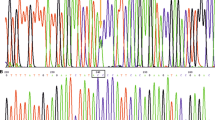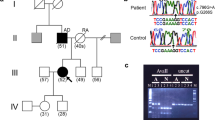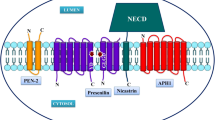Abstract
Background
Mutations in the presenilin proteins cause early-onset, familial Alzheimer’s disease (FAD).
Materials and Methods
We characterized the cellular localization and endoproteolysis of presenilin 2 (PS2) and presenilin 1 (PS1) in brains from 25 individuals with presenilin-mutations causing FAD, as well as neurologically normal individuals and individuals with sporadic Alzheimer’s disease (AD).
Results
Amino-terminal antibodies to both prese-nilins predominantly decorated large neurons. Regional differences between the broad distributions of the two presenilins were greatest in the cerebellum, where most Purkinje cells showed high levels of only PS2 immunoreactivity. PS2 endoproteolysis in brain yielded multiple amino-terminal fragments similar in size to the PS1 amino-terminal fragments detected in brain. In addition, two different PS2 amino-terminal antibodies also detected a prominent 42 kDa band that may represent a novel PS2 form in human brain. Similar to PS1 findings, neither amino-terminal nor antiloop PS2 antibodies revealed substantial full-length PS2 in brain. Immunocytochemical examination of brains from individuals with the N141I PS2 mutation or eight different PS1 mutations, spanning the molecule from the second transmembrane domain to the large cytoplasmic loop domain, revealed immunodecoration of no senile plaques and only neurofibrillary tangles in the M139I PS1 mutation stained with PS1 antibodies.
Conclusions
Overall presenilin expression and the relative abundance of full-length and amino-terminal fragments in presenilin FAD cases were similar to control cases and sporadic AD cases. Thus, accumulation of full-length protein or other gross mismetabolism of neither PS2 nor PS1 is a consequence of the FAD mutations examined.









Similar content being viewed by others
References
Levy-Lahad E, Wasco W, Poorkaj P, et al. (1995) Candidate gene for the chromosome 1 familial Alzheimer’s disease locus. Science 269: 973–977.
Sherrington R, Rogaev EI, Liang Y, et al. (1995) Cloning of a gene bearing missense mutations in early-onset familial Alzheimer’s disease. Nature 375: 754–760.
Rogaev EI, Sherrington R, Rogaeva EA, et al. (1995) Familial Alzheimer’s disease in kindreds with missense mutations in a gene on chromosome 1 related to the Alzheimer’s disease type 3 gene. Nature 376: 775–778.
Busciglio J, Hartmann H, Lorenzo A, et al. (1997) Neuronal localization of presenilin-1 and association with amyloid plaques and neurofibrillary tangles in Alzheimer’s disease. J. Neurosci. 17: 5101–5107.
Elder GA, Tezapsidis N, Carter J, et al. (1996) Identification and neuron specific expression of the S182/presenilin I protein in human and rodent brains. J. Neurosci. Res. 45: 308–320.
Lah JJ, Heilman CJ, Nash NR, et al. (1997) Light and electron microscopic localization of presenilin-1 in primate brain. J. Neurosci. 17: 1971–1980.
Lee MK, Slunt HH, Martin LJ, et al. (1996) Expression of presenilin 1 and 2 (PS1 and PS2) in human and murine tissues. J. Neurosci. 16: 7513–7525.
Moussaoui S, Czech C, Pradier L, et al. (1996) Immunohistochemical analysis of presenilin-1 expression in the mouse brain. FEBS Lett. 383: 219–222.
Murphy GM, Forno LS, Ellis WG, et al. (1996) Antibodies to presenilin proteins detect neurofibrillary tangles in Alzheimer’s disease. Am. J. Pathol. 149: 1839–1846.
Weber LL, Leissring MA, Yang AJ, Glabe CG, Cribbs DH, LaFerla FM. (1997) Presenilin-1 immunoreactivity is localized intracellularly in Alzheimer’s disease brain, but not detected in amyloid plaques. Exp. Neurol. 143: 37–44.
Giannakopoulos P, Bouras C, Kovari E, et al. (1997) Presenilin-1-immunoreactive neurons are preserved in late-onset Alzheimer’s disease. Am. J. Pathol. 150: 429–436.
Levey AI, Heilman CJ, Lah JJ, et al. (1997) Presenilin-1 protein expression in familial and sporadic Alzheimer’s disease. Ann. Neurol. 41: 742–753.
Cook DG, Sung JC, Golde TE, et al. (1996) Expression and analysis of presenilin 1 in a human neuronal system: localization in cell bodies and dendrites. Proc. Natl. Acad. Sci. U.S.A. 93: 9223–9228.
De Strooper B, Beullens M, Contreras B, et al. (1997) Phosphorylation, subcellular localization, and membrane orientation of the Alzheimer’s disease-associated presenilins. J. Biol. Chem. 272: 3590–3598.
Doan A, Thinakaran G, Borchelt DR, et al. (1996) Protein topology of presenilin 1. Neuron 17: 1023–1030.
Kovacs DM, Fausett HJ, Page KJ, et al. (1996) Alzheimer-associated presenilins 1 and 2: neuronal expression in brain and localization to intracellular membranes in mammalian cells. Nat. Med. 2: 224–229.
Zhang J, Kang DE, Xia W, et al. (1998) Subcellular distribution and turnover of presenilins in transfected cells. J. Biol. Chem. 273: 12436–12442.
De Strooper B, Annaert W, Cupers P, et al. (1999) A presenilin-1-dependent γ-secretase-like protease mediates release of Notch intracellular domain. Nature 398: 518–522.
Kim TW, Pettingell WH, Hallmark OG, Moir RD, Wasco W, Tanzi RE. (1997) Endoproteolytic cleavage and proteasomal degradation of presenilin 2 in transfected cells. J. Biol. Chem. 272: 11006–11010.
Mercken M, Takahashi H, Honda T, et al. (1996) Characterization of human presenilin 1 using N-terminal specific monoclonal antibodies: evidence that Alzheimer mutations affect proteolytic processing. FEBS Lett. 389: 297–303.
Seeger M, Nordstedt C, Petanceska S, et al. (1997) Evidence for phosphorylation and oligomeric assembly of presenilin 1. Proc. Natl. Acad. Sci. U.S.A. 94: 5090–5094.
Thinakaran G, Borchelt DR, Lee MK, et al. (1996) Endoproteolysis of presenilin 1 and accumulation of processed derivatives in vivo. Neuron 17: 181–190.
Thinakaran G, Harris CL, Ratovitski T, et al. (1997) Evidence that levels of presenilins (PS1 and PS2) are coordinately regulated by competition for limiting cellular factors. J. Biol. Chem. 272: 28415–28422.
Hartmann H, Busciglio J, Baumann KH, Staufenbiel M, Yankner BA. (1997) Developmental regulation of presenilin-1 processing in the brain suggests a role in neuronal differentiation. J. Biol. Chem. 272: 14505–14508.
Capell A, Saffrich R, Olivo JC, et al. (1997) Cellular expression and proteolytic processing of presenilin proteins is developmentally regulated during neuronal differentiation. J. Neurochem. 69: 2432–2440.
Kim TW, Pettingell WH, Jung YK, Kovacs DM, Tanzi RE. (1997) Alternative cleavage of Alzheimer-associated presenilins during apoptosis by a caspase-3 family protease. Science 277: 373–376.
Hendriks L, Thinakaran G, Harris CL, et al. (1997) Processing of presenilin 1 in brains of patients with Alzheimer’s disease and controls. Neuroreport 8: 1717–1721.
Podlisny MB, Citron M, Amarante P, et al. (1997) Presenilin proteins undergo heterogeneous endoproteolysis between Thr291 and Ala299 and occur as stable N- and C-terminal fragments in normal and Alzheimer brain tissue. Neurobiol. Dis. 3: 325–337.
Okochi M, Ishii K, Usami M, et al. (1997) Proteolytic processing of presenilin-1 (PS-1) is not associated with Alzheimer’s disease with or without PS-1 mutations. FEBS Lett. 418: 162–166.
Mathews PM, Martinie JB, Fambrough DM. (1992) The pathway and targeting signal for delivery of the integral membrane glycoprotein LEP100 to lysosomes. J. Cell Biol. 118: 1027–1040.
Li J, Ma J, Potter H. (1995) Identification and expression analysis of a potential familial Alzheimer disease gene on chromosome 1 related to AD3. Proc. Natl. Acad. Sci. U.S.A. 92: 12180–12184.
Mirra SS, Heyman A, McKeel D, et al. (1991) The consortium to establish a registry for Alzheimer’s disease (CERAD). Part II. Standardization of the neuropathologic assessment of Alzheimer’s disease. Neurology 41: 479–486.
Koff A, Giordano A, Desai D, et al. (1992) Formation and activation of a cyclin E-cdk2 complex during the G1 phase of the human cell cycle. Science 257: 1689–1694.
Mercken M, Vandermeeren M, Lubke U, et al. (1992) Monoclonal antibodies with selective specificity for Alzheimer Tau are directed against phosphatase-sensitive epitopes. Acta Neuropathol. 84: 265–272.
Cataldo AM, Nixon RA. (1990) Enzymatically active lysosomal proteases are associated with amyloid deposits in Alzheimer brain. Proc. Natl. Acad. Sci. U.S.A. 87: 3861–3865.
Ratovitski T, Slunt HH, Thinakaran G, Price DL, Sisodia SS, Borchelt DR. (1997) Endoproteolytic processing and stabilization of wild-type and mutant presenilin. J. Biol. Chem. 272: 24536–24541.
Citron M, Westaway D, Xia W, et al. (1997) Mutant presenilins of Alzheimer’s disease increase production of 42-residue amyloid β-protein in both transfected cells and transgenic mice. Nat. Med. 3: 67–72.
Levesque L, Annaert W, Craessaerts K, et al. (1999) Developmental expression of wild-type and mutant presenilin-1 in hippocampal neurons from transgenic mice: evidence for novel species-specific properties of human presenilin-1. Mol. Med. 8: 542–554.
Wisniewski T, Dowjat WK, Buxbaum JD, et al. (1998) A novel Polish presenilin-1 mutation (P117L) is associated with familial Alzheimer’s disease and leads to death as early as the age of 28 years. Neuroreport 9: 217–221.
Lemere CA, Blusztajn JK, Yamaguchi H, Wisniewski T, Saido TC, Selkoe DJ. (1996) Sequence of deposition of heterogeneous amyloid β-peptides and APO E in Down syndrome: implications for initial events in amyloid plaque formation. Neurobiol. Dis. 3: 16–32.
Borchelt DR, Thinakaran G, Eckman CB, et al. (1996) Familial Alzheimer’s disease-linked presenilin 1 variants elevate Aβ 1–42/1–40 ratio in vitro and in vivo. Neuron 17: 1005–1013.
Duff K, Eckman C, Zehr C, et al. (1996) Increased amyloid-β42(43) in brains of mice expressing mutant presenilin 1. Nature 383: 710–713.
Lee MK, Borchelt DR, Kim G, et al. (1997) Hy-peraccumulation of FAD-linked presenilin 1 variants in vivo. Nat. Med. 3: 756–760.
Marambaud P, Alves da Costa C, Ancolio K, Checler F. (1998) Alzheimer’s disease-linked mutation of presenilin 2 (N141I-PS2) drastically lowers APPα secretion: control by the proteasome. Biochem. Biophys. Res. Commun. 252: 134–138.
Marambaud P, Ancolio K, Lopez-Perez E, Checler F. (1998) Proteasome inhibitors prevent the degradation of familial Alzheimer’s disease-linked presenilin 1 and potentiate Aβ42 recovery from human cells. Mol. Med. 4: 147–157.
Honda T, Yasutake K, Nihonmatsu N, et al. (1999) Dual roles of proteasome in the metabolism of presenilin 1. J. Neurochem. 72: 255–261.
Steiner H, Capell A, Haass C. (1999) Proteolytic processing and degradation of Alzheimer’s disease relevant proteins. Biochem. Soc. Trans. 27: 234–242.
Fraser PE, Levesque G, Yu G, et al. (1998) Presenilin 1 is actively degraded by the 26S proteasome. Neurobiol. Aging 19: S19–S21.
Acknowledgments
This work was supported by a LEAD (leadership and Excellence in Alzheimer Disease) grant from the NIA (R. N. and A. C.; AG10916) and a NRSA fellowship (P. M.; NS09848). Human brain tissue was provided in part by the Harvard Brain Tissue Resource Center, which is supported in part by the PHS grant number MH/NS 31862 and the Kathleen Price Bryan Brain Bank at Duke University Medical Center. We wish to thank Drs. Gopal Thinakaran and Sangram Sisodia for providing us with the N2a cell extracts and the anti-loop PS2 polyclonal antibody.
Author information
Authors and Affiliations
Corresponding author
Rights and permissions
About this article
Cite this article
Mathews, P.M., Cataldo, A.M., Kao, B.H. et al. Brain Expression of Presenilins in Sporadic and Early-onset, Familial Alzheimer’s Disease. Mol Med 6, 878–891 (2000). https://doi.org/10.1007/BF03401825
Accepted:
Published:
Issue Date:
DOI: https://doi.org/10.1007/BF03401825




